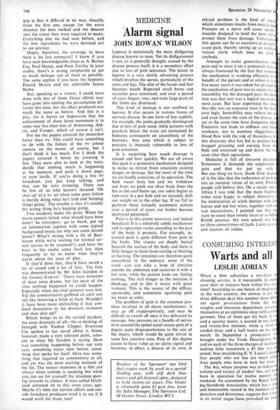MEDICINE
Alarm signal
JOHN ROWAN WILSON
Leprosy is notoriously the most disfiguring disease known to man. Yet its disfigurement is not, as is generally thought, caused by the disease process itself; it is a secondary effect due to loss of pain sensation. The lesion in leprosy is a very slowly advancing process which involves the nerves, particularly of the arms and legs. The skin of the hands and feet becomes numb. Repeated small burns and scratches pass unnoticed, and over a period of years fingers, toes, and even large parts of the limbs are destroyed.
This kind of damage is not confined to leprosy. It also occurs in various forms of nervous disease. In one form of late syphilis, for example, the joints gradually disintegrate due to loss of pain sense, while patients with paralysis below the waist are tormented by bedsores consequent on anaesthesia of the buttocks. Any area which is subject to pressure is intensely vulnerable to loss of pain sensation.
It is surprising how much damage is caused and how quickly. We are all aware that pain is a protective mechanism designed to make us retreat from situations causing danger or damage, but for most of the time we are hardly conscious of its operation. The bath water feels hot and we withdraw our foot; we push our chair back from the fire as the coal burns up; our ankle begins to turn over in a pot hole and we instantly shift our weight on to the other leg. If we fail to perform these virtually automatic actions over a period of years our bodies become destroyed piecemeal
Pain is to this extent necessary and indeed beneficial. It is a relatively subtle mechanism and its operation varies according to the part of the body it protects. For example, in- testinal pain is quite different from pain in the limbs. The viscera are deeply buried beneath the surface of the body and there is little danger to them from cutting or bruising or burning. The intestines are therefore quite anaesthetic in the ordinary sense of the word—you can take a loop of intestine outside the abdomen and cauterise it with a hot wire, while the patient looks on, feeling nothing. The real danger to the intestine is blockage, and to this it reacts with great violence. This is the source of the diffuse, spasmodic, and sometimes agonising pain we know as colic.
The problem of pain is the common pro- blem involved in all alarm mechanisms: it may go off inappropriately, and may be difficult to switch off once it has delivered its message. Any pressure on a bundle of nerves in or around the spinal canal causes pain of a degree quite disproportionate to the size of the injury, which would be quite trivial in some less sensitive area. Pain of this degree ceases to have value as an alarm signal and becomes, in effect, a disease of its own. A
related problem is the kind of situat which sometimes results from muscle spa Pressure on a nerve will cause spasms muscles designed to hold the joint still protect them from damage. Unfortunat this spasm can be so excessive as actually cause pain, thereby setting up an unplea; vicious circle which does no goon anybody.
Attempts to make generalisations a pain and to treat it on a systematic basis always frustrated by the fact that someti the mechanism is working efficiently to benefit of the patient and at others it is n For many years it was taken for granted t the mechanism of pain was to secure rest a immobility for the damaged part; the ded tion was that rest was a logical treatment most cases. But later experience has sho that this was an excessive trust in the bod own logic. Immobility may relieve the p and even hasten the cure of the disease, a yet at the same time have dangerous effec Excessive rest leads to stiffness and mu weakness, not to mention sluggishness blood flow with the risk of thrombosis. It this discovery that has led to patients bei dragged groaning and cursing from th beds and exercised up and down the v.a soon after their operations.
Medicine is full of tiresome paradox Sometimes it demands the suppression pain and that we put up with
But one thing we have, thank God, dispo of is the idea that the endurance of pain ca ries an intrinsic virtue of its own. Primiti people still believe this. On a recent tour Africa I was told. that the more backss tribes were happy to subject themseke, the ministration of witch doctors with dr knives and red hot wires, together with e, tain incantations. I pointed out that it were no more than twenty years or so belt British practice. My own school was bu on three cornerstones of faith: Latin, cascar and tincture of iodine.










































 Previous page
Previous page